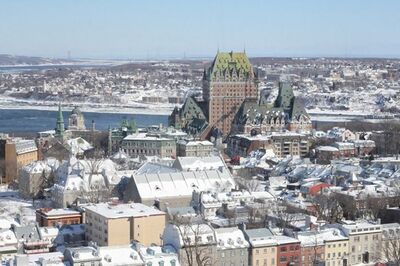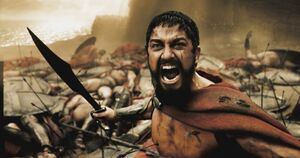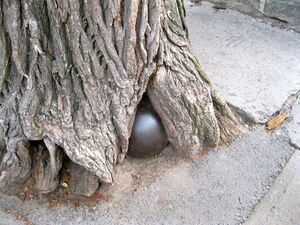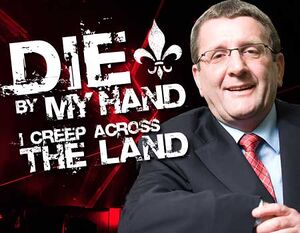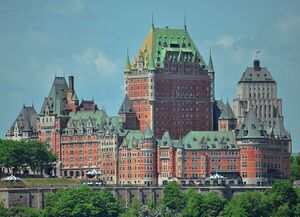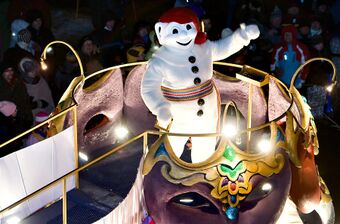Quebec City
Quebec City is the oldest city in North America, plain and simple. It is the capital of the province of Quebec, which is part of a political misunderstanding known as Canada. The city was founded as a fur trading settlement by Samuel de Champlain under the name Stadacona, which is Amerindian for "the place where one is as high as a kite." Indeed, it is a geological plateau with a steep climb on all sides, allowing a bird's-eye view of the surrounding terrain with which to predict the next flying beluga attack, a pleasant challenge for hikers, and the perfect nesting ground for chipmunks. It likewise makes a foolish site on which to build a city, but as history often proves, stubbornness always wins out over intelligence.
History
Foundation
Quebec was founded in 1608 by nobleman Samuel de Champlain, who had no choice but to stop there since his boat was rotting up to the waterline and his crew was plagued by the scurvy. He disembarked (well, swam ashore) to ask the Natives if they could be of help. More than happy to oblige, the Huron tribe stationed in Kebek (literal translation: "Where the moose are big as fuck") provided them with their highest technology: oranges, the remedy of choice for the scurvy. An incredibly grateful Champlain spent the winter in the Natives' huts, which were heated with deer droppings and the shaman's Holy Furnace, until his magic points were depleted.
When spring came, Champlain repaired his boat with birch bark and pine gum to hold everything together, sailed back to Europe and left a small settlement behind. Although the living conditions were harsh, the French people were happy and learned to communicate with the neighboring Hurons and Algonquins with body language, smiles and punches, and shared their tradition of smoking weed in a calumet. Everything was fine and dandy until the wretched Englishmen came to soil the land with their foul breath and wars.
Conquest and failed conquests
In 1759, after much shenanigans over the control of the lucrative beaver fur market, the Battle of the Plains of Abraham (or Battle of Quebec (1759)) took place. The English were led by James "Just here to steal your Land" Wolfe and met a valiant resistance by Louis-Joseph "Over my dead body" Montcalm and the French people. After the sinking of numerous English vessels thanks to saw-equipped war salmons, the British switched tactics and set camp ashore at Cap-Rouge (Bloody Cap), hidden from French view. The French opened the wine bottles and roasted a few English prisoners to celebrate, since they thought the enemy had retreated. In the middle of the night, the British surreptitiously attacked, and much of the French never knew what killed them. The few half-drunk soldiers who woke up basically killed one another in the darkness and frenzy. Such is the glorious history of Quebec City's taking. Or is it?
Only a year later, the French won the Battle of Quebec (1760), as the new British despot was forced to flee like a scalded dog back to the fortified city after his army was beaten to a pulp with freshly baked baguettes. But they say that the victors write the history; and as the British were taking control of the rest of North America, this piece of history would meet the same eventual fate as those baguettes down the toilet.
The next major battle, surprisingly also named the Battle of Quebec (1775), is likewise forgotten now,[1] as the invading Americans suffered a humiliating defeat. The Americans got giddy after evicting the English from their own land and showed a prelude of their future foreign policy by invading New France. Guy Carleton, a former American soldier who defected because he was sick of buffalo jerky rations, vowed to defend New France and became Quebec's general.
The Quebec militia doesn't deserve much credit for the crushing victory, as they only had to wait to see that the American leaders' thirst for power was inversely proportional to their wits. Carleton had learned that an American army was afoot for the motherland, bearing muskets, harpoons and sandals. The strategy was simple: hoard as much grain, wine and weed as possible within the city's walls to last for a while and watch the "besiegers" compose with the difference between Quebec's winter and the American one, which is like comparing a freezer to a refrigerator. The guards patrolling the city's walls, warm bear fur on the shoulders and hot moose stew in the belly, would often shout to the freezing fellows below to save their skin, which they ultimately did by retreating. The conflict sadly cost 50 American casualties, and over 400 prisoners, since they were left stuck in the ice. Five Quebecers perished during the siege, one to diabetes, the other four dying of old age.
Modern Quebec City
Quebec City is the second biggest agglomeration to use the French language in North America thanks to a population of one million sash wearers, but could very well steal the top spot from Montreal soon since English-speaking people are multiplying down there like monkeys in mating season. However, there are a few English pockets in Quebec City, most notably the jail and the asylum. There is no racism and no ghettos in the city, which is remarkable considering its size: the Black and Asian minorities are blending perfectly (as perfectly as black can blend in a white background) and numerous sightings are routinely reported anywhere in the town, for the immigrants see no point in living clogged together in a community that accepts them so openly. However, should a full sentence pronounced in English come to the ears of a Police officer or a benevolent Vigilante (99% of the population), ID cards are immediately demanded, whether the person is white, black or blue. If the suspects have been staying in Quebec City for more than 2 years and have not yet learned French to a level that is satisfactory, they are accused of the latest unsolved crime and shipped back home. Et voilà! Bon débarras!
Mayor Labeaume
“Mon osti, m'as t'en câlisser une dans l'front! (Motherfucker, I'll bash your fucking brains in!)”
Dictator by day, house burglar and hitman by night, mayor Régis Labeaume is hugely popular in the city and will be the Dear Leader for life, or at least until he finally gets a NHL hockey team to come back in town. A big reason for his success is his straight talk and populist language (see quote above). He was infuriated when the Canadian government, which had promised to help the hockey team's return before the elections, turned its back on Quebec's people once the election was over by backpedaling and refusing to contribute one cent toward the new arena. In a moment of holy anger, the mayor spoke aloud (and very publicly) what everybody thought but would not say about the Canada's representative for Quebec City, Josée Verner. He stated that she was "an old, hypocritical cow" and that "there are times where I just feel like beating the heck out of her." This passionate rant gained him 25 points in the polls, but elicited his usual half-assed apology: "I got a bit carried away there...."
The mayor has 2 bodyguards with him at all times, but their mandate is not to protect him (as he is more than capable of that) but to keep him from assaulting anybody who disagrees with his policies.
His main argument during the municipal elections? "We are close to getting a hockey team back, but if I'm not in power to shake things up, it will not work. Also, I think my opponent wants to close down all the brothels I tolerate, isn't it?" Reelection guaranteed every time!
Places of interest
The Château Frontenac
The Château Frontenac, also known as The Bowser Castle, is an hotel that opened its doors in 1893 to lodge the rich intelligentsia. Not a single Quebec working man nor woman could get in, and it is still very true to this day, unless one is willing to sell his house to have the opportunity to spend a night there. Its architectural style is modeled after a castle, with pillars, windows, walls, and whatnot. It is heavily rumored that some parts of the castle have been closed down in recent years due to an outbreak of Koopa Troopas, Hammer Brothers and piranha plants coming out of the piping, and that an Italian plumber has been hired to try to quell the problem.
The Pont de Québec
The bridge holds the world record for being the longest cantilever bridge on the planet, but the price to pay to have this bragging right was hefty, as the bridge collapsed during its construction not only once, but twice, which is another world record. Crossing the St-Lawrence River, the piece of infrastructure is not suitable for the faint of heart: the old, rusted-to-the-core rivets that are holding the thing together squeak loudly as one crosses it, hinting that something bad will happen very soon. To minimize the risks, Quebecers build momentum by flooring the gas pedal while still on firm ground and cross the bridge at about 150 miles per hour. Getting a ticket for speeding is an impossibility, since no police officers are crazy enough to park their cruisers on the bridge.
The Grande Allée
The charming street, covered with centenary trees, is quite a sight during daytime: beautiful women, old buildings, centenary trees, fat women and centenary trees are part of the scenery. At night, things tend to be a little more hectic, especially at exactly 3 a.m., when the street's 64 bars close simultaneously. The sudden flow of drunkards can do just about anything, since the police union is so strong that there is no night shift. The city merely rebuilds the street and washes away the puke, as English-speaking tourists help replenish the government coffers when hospitalized for brutal, alcohol-fueled attacks. Healthcare may be free for the natives, but the government compensates by charging $1,000 per stitch to foreigners.
The Plaines d'Abraham
A flat piece of land where people come to relax and entertain themselves by throwing frisbees and baseballs at English tourists and lying in the grassy fields, this emplacement is Quebec City's equivalent of Central Park, minus the rats and crocodiles. The locals seem unconcerned that their ancestors fought there and spilled their blood to enrich the land with fertilizers and micronutrients thanks to their decomposing bodies. An incredible amount of historical cannons are scattered everywhere, and some speculate that this is a covert maneuver from the City Council to have an immense source of iron should the global stocks run dry.
Notable events
No winter could be complete in the city without a good public showing of mass drunkenness. The Carnaval is vital to the region's agriculturo-culturo-historico-economical industry, since a scary amount of alcohol is consumed. A bunch of Carnaval floats roam through the streets, la pièce de résistance being the Bonhomme Carnaval himself, a mascot that is steel-plated to withstand the abuse of the crowd. The problem with the parade is that people throwing their empty beer bottles from the sidewalk may miss the mascot and put in jeopardy the bottle-throwers on the other side. But as alcohol is a good anesthetic, the pleasure of taking aim at the mascot far outweigh the occasional shattering of beer bottles on a reveler's face. The city officials, being very concerned about the health hazards of the situation, took a step in the right direction in 2012, distributing free bottles of 40% alcohol, which knocks out the revelers in a jiffy and produces a lot less empty containers. Bulldozer operators do good business the next day, cleaning the streets of frozen human debris.
The Saint-Jean-Baptiste
Each June 24, Quebec citizens bring their family to the Plains of Abraham to celebrate the Independence of the Motherland. In a solemn moment, the countless Canadian flags in the crowd emit a warm, glowing light as they are set ablaze, while songs of Quebec's heritage like Gens du Pays (People of the Land) and C'est une langue belle (This language ain't too bad at all) resonate in the city and in the people's hearts. The evening concludes with an enormous fire lit with books written in Ontario, where thousands of denizens are grilling marshmallows and maple-syrup-covered trout. A free poutine buffet is then served, and everyone just collapses after the meal from the intense emotions of the evening and the cholesterol shock induced by the poutine.
Notes
- ↑ Indeed, all our textbooks on Canadian history come from publishing companies in the United States. Happily, they comply with the law by including at least 50% Canadian content.
Related stuff
| Featured version: 31 August 2012 | |
| This article has been featured on the main page. — You can vote for or nominate your favourite articles at Uncyclopedia:VFH. | |
